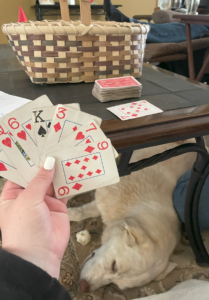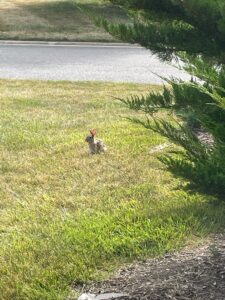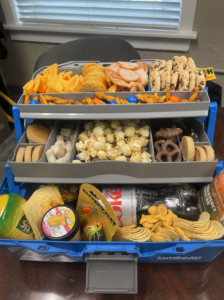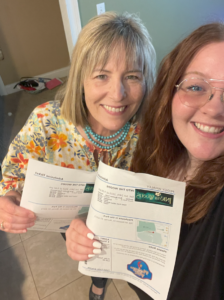Hello everyone! I hope that my blog post finds you well. My name is Ashlee Petranovich and I am currently in Murray, Kentucky attending Murray State University. While I am here on my internship I will be collaborating with four different programs that are focused on mental health, school safety, school psychology, and psychological assessments. These programs are indirectly or directly associated with the College of Education and Human Services at Murray State. The work that I will be completing in the next 7 weeks aligns with the following bullet points:
- Grant implementation experience through the MSU/WKEC Mental Health Providers Academy grant
- Counseling and assessment experience shadowing school psychology interns as they complete screening for and diagnosis of autism spectrum disorder in youth clients
- Assisting faculty with literature reviews on manuscripts and grants
- Website enhancements for KY School Safety
- Assisting the Center for Student Engagement and Success
- Sharing my perspective and knowledge
*Due to confidentiality and working with human subjects I am limited in what exactly it is that I can write about/post pictures of*
MONDAY, JUNE 19TH
Today, the university was closed due to a holiday. I spent the day working on some side projects and organizing my week will look like. My aunt and I went to go get Mexican food for lunch since we both had the day off. I had the Speedy Gonzalez order and unfortunately, I did not turn into The Flash. Despite this, it was nice to spend time together!
TUESDAY, JUNE 20TH
Today I had class where we learned about Behavior Disruptive Disorders. We started out with a warm-up that was essentially reviewing last week’s material. The warm-up was: You are assessing a student for suspected ADHD using a variety of psychological assessments. Discuss how your collected assessment data are conceptualized against the criteria for psychopathology. The criteria for this calls for the situation to be relatively infrequent, culturally deviant, impaired, and personal distress. The idea behind this is that you can’t check off these boxes for a case, then it is not true pathology. After the warm-up, we discussed how long Behavior Disruptive Disorders have been studied and the history behind it. This involved discussing Achenbach (1966) who established the two-factor model for child psychopathology. Child psychopathology refers to the scientific study of mental disorders in children and adolescents. This model entails internalizing pathology and externalizing pathology. Internalizing psychopathology are inner-directed problems that generate tension and suffering within the individual. The individual may be anxious, withdrawn, and have somatic complaints. Disorders that fall under the internalizing psychopathology are often more difficult to detect than overt behavioral problems. On the other hand of Achenbach’s model, it addresses the externalizing problems found in disorders. These are outer-directed problems and have a direct effect on others, which can leave a lasting feeling of general discomfort and conflict. After this, we discussed ODD (Operational Defiant Disorder), which is an ongoing pattern of anger guided disobedience. This disorder is a disorder that includes an individual having angry, defiant, irritable, oppositional behaviors. ODD can be observed as something that can be vindictive along with having functional disruptive behavior, and not age appropriate. We then discussed CD (Conduct Disorder), which is a different type of reaction, which is a reaction to aversive situations. This disorder stops being functional and the individual has an intent to harm. An individual with this disorder may engage in includes assault, property destruction, or chronic lying. With CD there is two types: Child-onset and adolescent-onset. Dr. Simons spoke more on callous-unemotional traits that may be attached to Disruptive Disorder. Callous traits have a lack of empathy, absence of guilt, and have a uncaring attitude. Unemotional traits are defined by shallow or deficit of emotional responses. After this, we learned about proactive aggression and reactive aggression.
Reactive Aggression(W/O CU):
- A lack of self control
- Anger, frustrating, revenge
- Often triggered but no plan to enact it
- Outbursts of temper, physical fights, or damaging property in response to
Proactive Aggression (CU):
- Premeditated
- Bullying, coercion, violence
- Intent to harm
I learned about the prognosis projected for people with CU between a child and a adolescent. Alongside this we talked about the practices and methods of treatment for people with ODD.
There was a lot more that I learned today but this was the primary gist of what we talked about! I really enjoyed this class this week!
WEDNESDAY, JUNE 21ST
Today was observation day where I got to go in and observe the grad interns while they completed diagnostic screenings for patients. Today started out as a no-show but then, our patient came in at around 11:45 thankfully. During the time before the patient would come in, I asked if I would be able to preview the tests that we would be administrating for the day and was able to look over the WISC-V test. I have written lightly on this topic before in my blogs, but since I got to learn more about the test today, I will go over what the general purpose is of the WISC-V test and what I found interesting about the test! *All of this below comes from the WISC-V book*
The Wechsler Intelligence Scale for Children is an individually administered, comprehensive clinical instrument for assessing the intelligence of children aged 6 years and 0 months –> 16 years and 11 months. The WISC-V provides subtests and composite scores that represent intellectual functioning in specific cognitive domains such as verbal comprehension or working memory. This serves as a way to represent intellectual functioning within a individual. Since I have seen this test be administered before, I wanted to mainly understand the general guidelines of the test, the ideal behavior from the examiner, and how the examiner is supposed to score the subtests. The WISC-V requires the examiner to have a familiarity with test materials before administering the test, presenting the test in a good environment (distraction-free), and establishing and maintaining rapport. This leads into the behavior that is expected of the examiner, which is for them to come off as professional, unhurried, and interested toward the patient. What I found interesting about this test is that it often would help guide the examiner in conversations with patients. While I think it is a common saying that children are unpredictable and will do the unexpected, the WISC-V test has the behaviors and responses that will surface from a child on lock down! This test takes into account something that I have seen a lot over the past couple of weeks while observing: a disengaged child who dismisses testing and comes off very “flat” while testing. Some children will often shrug or stay completely silent when it comes to testing. It is not a matter of them not knowing how to perform a given task; rather it is the child not wanting to perform the given task. The child is capable but is not engaged, overly stimulated, or has high anxiety. The WISC-V takes into account this and provides ways to avoid having a poor testing time and make sure that the test suits different types of children. The situation for a child to come to the clinic, a place where they have never been before, and sit in a room with a stranger and take a test can be daunting. Some children may feel pressured when it comes to hearing that they will be tested and may press on about how this is a test. In the event in which the child asks the examiner, “is this a test?” the examiner should respond, “Yes, but it is a different type of test, not like a school test.” The examiner should also display and communicate enthusiasm and interest by praising the child’s efforts while they complete the test. This should be demonstrated by saying phrases that commemorate the work that a child is completing, not necessarily on if the child is getting the answers right or wrong. For example, phrases like, “You’re working hard,” “I like that you are trying your best,” “You are doing a great job,” work well for children and encourage them to continue to be engaged. It was nice to learn more about the test and what the guidelines were! I want to do a deeper dive into all of the tests here soon.
The case today was for a child whose parent was concerned about their child’s anger and delay of development. I sat in on the parental interview and got to know more of the parent’s concerns for their child. While I won’t go further into the concerns/situation for the family, I will note that this case fell under what I learned about in class yesterday. I thought it was very interesting that what we learned yesterday was being applied to today’s case.
After this, I headed home and ran to the pond, had dinner, and then made some cake pops for my aunt’s office and for my family!
THURSDAY, JUNE 22ND
Today was another day at the clinic completing observations with the graduate students. In the clinic it was just two other graduate students and me. Thankfully, today’s client showed up early and we were able to go ahead and get started on their screening. The age of the client was fit for the BASC, WJ, and an achieve test. I have previously learned about the WJ and achievement screening tests, but today was the first time I had the opportunity to sit in and observe a BASC for a child. Normally, the child would be able to fill out the BASC on their own, but today the child requested that we would help and read out the questions to him. The BASC stands for Behavior Assessment System for Children and measures behavioral strengths and weaknesses. The test will lay out a statement such as “I find it easy to make friends,” and from there, the child will answer either true or false. Or, if the child is on the next section, the child will respond with either never, sometimes, often, or almost always. I was able to observe the child, and based on initial behavior it was presumed that they had ADHD. Despite this initial impression, the examiner has to keep an open mind and be open to different possibilities for the child. After this test, I sat in for the parent interview, which is something that I have found a lot of enjoyment in. The parent interview allows for the examiners to gain more background information for their reports and clarify any of the parent’s concerns for their child. While all of this information from the parents is useful to me to be able to understand other variables that contribute to how a child behaves, I believe that being able to sit in and simply listen to the parent has opened my eyes to all of the different situations that people have to undergo. Not only have I been able to truly empathize with those I speak with, I have also had my heart softened and humbled. The people that you meet during this process are truly the sweetest people who are seeking help with their children. I feel so grateful to be a part of this experience and aid them in getting that help in some way.
Today’s testing screened the child with ADHD rather than Autism after the child took a BRIEF-2 test and I got to be a part of the debriefing part of the day and it was a great experience. The child loved giving hugs and made sure to give the other testers and I big hugs as we wrapped up the day. The people who come into the clinic are amazing!
After this, I headed home and enjoyed the rest of the afternoon with family.
FRIDAY, JUNE 23RD
Today I went with my aunt over to her office to celebrate her coworker’s birthday and attend a meeting with Dr. Robertson, the vice president of student affairs. After my meeting with him, we went to the library to go check out a book I have to read over the summer for AP Literature: “Oedipus The King”. While checking out this book, I wandered over to the psychology section of the library and looked over the titles they had on display. The oldest book I could find was as book published in 1913! I checked out some sport psychology books to do some research for my other internship. After this, my aunt and I went to Aurora, KY and went to a large lake so that Saylor (and I) could swim and soak up the sun. It was a perfect day!
SATURDAY, JUNE 24TH
Today was spent at home but with usual routines of going to the pond, cleaning up, etc. But today my aunt and I were going to a play at the local theatre. The play for the night was Into the Woods and to say it was magical was an understatement. There were such talented people performing and the singing was absolutely amazing. Such a fun night with my aunt. I am sad that I will be gone before I can see their next play they will be performing in August!
Thank you for reading! See you next week!














Sounds like another action packed week for you. You definitely are working very hard and your dad and I are very proud of you. We love you and miss you. ❤️
Love you mom so much! I get it all from you guys. Miss you both.